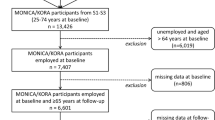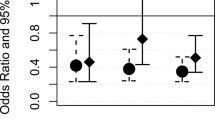Abstract
This study investigated how socioeconomic factors and psychosocial conditions are related to self-reported health among 43-year-old women representing the general Swedish population (N = 569). Odds ratios and multiple logistic regression analyses were used for associations and effect modification, adjusted for symptom reporting in adolescence. Poor self-reported health was predicted by low income, financial worries, and job strain, as well as combined exposure to a high level of unpaid household work and job strain (double burden). In conclusion, poor psychosocial conditions related to working life, as well as to the combined impact of paid and unpaid work were revealed to be risk factors for poor self-reported health among middle-aged women. These results highlight the need for improving women’s work conditions, as well as designing family policies that promote a better sharing of unpaid household tasks and responsibilities between spouses.
Similar content being viewed by others
References
Angel, R. J., Frisco, M., Angel, J. L., & Chiriboga, D. A. (2003). Financial strain and health among elderly Mexican-origin individuals. Journal of Health and Social Behavior, 44, 536–551.
Arber, S. (1997). Comparing inequalities in women’s and men’s health. Britain in the 1990’s. Social Science and Medicine, 44, 773–787.
Aro, H., & Taipale, V. (1987). The impact of puberty on psychosomatic symptoms among fourteen to sixteen-year old Finnish girls. Child Development, 58, 261–268.
Bartley, M., Sacker, A., Firth, D., & Fitzpatrick, R. (1999). Social position, social roles and women’s health in England: Changing relationships 1984-1993. Social Science and Medicine, 48, 99–115.
Björner, J. B., Söndergaard-Kristensen, T., Orth-Gomér, K., Tibblin, G., Sullivan, M., & Westerholm, P. (1996): Self-rated health. A useful concept in research, prevention and clinical medicine. Swedish council for planning and coordination of research.
Bullers, S. (1994). Women’s roles and health: The mediating effect of perceived control. Women and Health, 22, 11–30.
Crafoord, K. (1972). Symptom or age-specific behavior? A study of 15-year old girls. Unpublished licentiate thesis, Department of Psychology, Stockholm University, Sweden.
Emslie, C., Hunt, K., & Macintyre, S. (1999). Problematizing gender, work and health: The relationship between gender, occupational grade, working conditions and minor morbidity in full-time bank employees. Social Science and Medicine, 48, 33–48.
Fritzell, J., & Lundberg, O. (2000). Welfare, disadvantage, and inequality. Stockholm: SOU 2000: 41 pp. 56–60.
Gjesdal, S., & Bratberg, E. (2002). The role of gender in long-term sickness absence and transition to permanent disability benefits. Results from a multiregister-based, prospective study in Norway 1990-1995. European Journal of Public Health, 12, 180–186.
Gove, W. R. (1984). Gender differences in mental and physical illness: The effects of fixed roles and nurturant roles. Social Science and Medicine, 19, 77–91.
Griffin, J. M., Fuhrer, R., Stansfeld, S. A., & Marmot, M. (2002). The importance of low control at work and home on depression and anxiety: Do these effects vary by gender and social class? Social Science and Medicine, 54, 783–798.
Hall, E. M. (1992). Double exposure: The combined impact of the home and work environment on psychosomatic strain in Swedish women and men. International Journal of Health Services, 22, 239–260.
Hemingway, H., Shipley, M., Stansfeld, S., & Marmot, M. (1997). Sickness absence from back pain, psychosocial work characteristics and employment grade among office workers. Scandinavian Journal of Work Environment and Health, 23, 121–129.
Karasek, R. A. (1979). Job demands, decision latitude and mental strain: Implications for job design. Administrative Science Quarterly, 24, 285–308.
Karasek, R., & Theorell, T. (1990). Healthy work. Stress, productivity and the reconstruction of working life. New York: Basic Books.
Krantz, G., Berntsson, L., & Lundberg, U. (2005). Total workload, work stress, and perceived symptoms in Swedish male and female white-collar employees. European Journal of Public Health, 15, 209–214.
Krantz, G., & Östergren, P.-O. (1999) Women’s health: Do common symptoms in women mirror general distress or specific disease entities? Scandinavian Journal of Public Health, 27, 311–317.
Krantz, G., & Östergren, P.-O. (2001). Double exposure: The combined impact of domestic responsibilities and job strain on common symptoms in employed Swedish women. European Journal of Public Health, 11, 413–419.
Lindén, K. (1991). Women—Health—Action. Doctoral dissertation, Department of Social Work, Gothenburg University, Sweden.
Lundberg, U., Mårdberg, B., & Frankenhaeuser, M. (1994). The total workload of male and female white collar workers as related to age, occupational level, and number of children. Scandinavian Journal of Psychology, 35, 315–327.
Macran, S., Clarke, L., & Joshi, H. (1996). Women’s health: Dimensions and differentials. Social Science and Medicine, 42, 1203–1216.
Magnusson, D. (1988). Individual development from an interactional perspective: A longitudinal study. Mahwah, NJ: Lawrence Erlbaum Associates, Inc.
Magnusson, D. (1998). The logic and implications of a person approach. In R. B. Cairns, L. R. Bergman, & J. Kagan (Eds.), Methods and Models for Studying the Individual (pp. 33–63). Thousand Oaks, CA: Sage.
Malterud, K. (1987a). Illness and disease in female patients. Pitfalls and inadequacies of primary health care classification systems—A theoretical review. Scandinavian Journal of Primary Health Care, 5, 205–209.
Malterud, K. (1987b). Illness and disease in female patients II. A study of consultation techniques designed to improve the exploration of illness in general practice. Scandinavian Journal of Primary Health Care, 5, 211–216.
Manderbacka, K. (1998). Questions on survey questions on health. Doctoral dissertation, Swedish Institute for Social Research, Stockholm University, Sweden.
Mårdberg, B., Lundberg, U., & Frankenhaeuser, M. (1991). The total workload of parents employed in white collar jobs: Construction of a questionnaire and a scoring system. Scandinavian Journal of Psychology, 32, 233–239.
Mellner, C., & Lundberg, U. (2003). Self- and physician-rated general health in relation to symptoms and diseases among women. Psychology, Health, and Medicine, 8, 123–135.
Näswall, K., Sverke, M., Isaksson, K., Johansson, G., & Lindroth, S. (2002). Arbete, utbildning, familj: Beskrivande statistik från den personliga intervjun i IDA II [Work, education, family: Descriptive statistics from the personal interview in IDA-II] (Tech. rep. no. 80). Stockholm, Sweden: Department of Psychology, Stockholm University.
National Authority of Social Insurances in Sweden [RFV]. (2002). Statistics information Is-I 2002:4.
Norusis, M. (1994). Statistical package for the social sciences. Professional statistics release 6.1 [Computer software]. Chicago: SPSS.
Rothman, K. J. (1986). Modern Epidemiology. Boston: Little, Brown.
Schnall, P. L., Landsbergis, P. A., & Baker, D. (1994). Job strain and cardiovascular disease. Annual Review of Public Health, 15, 381–411.
Schwartzberg, N. S., & Dytell, R. S. (1996). Dual-earner families: The importance of work stress and family stress for psychological well-being. Journal of Occupational Health Psychology, 2, 211–223.
Szulkin, R., & Thålin, M. (1994). Vardagens villkor [Everyday conditions]. Stockholm: Brombergs förlag.
Tibblin, G., Bengtsson, C., Furunes, B., & Lapidus, L. (1990). Symptoms by age and sex. Scandinavian Journal of Primary Health Care, 8, 9–17.
Waite, L. (1995). Does marriage matter? Demography, 32, 483–507.
Waldron, I., Hughes, M. E., & Brooks, T. L. (1996). Marriage protection and marriage selection—Prospective evidence for reciprocal effects of marital status and health. Social Science and Medicine, 43, 113–123.
Waldron, I., Weiss, C. C., & Hughes, M. E. (1998). Interacting effects of multiple roles on women’s health. Journal of Health and Social Behavior, 39, 216–236.
Walters, V., Lenton, R., & McKeary, M. (1995). Women’s health in the context of women’s lives (Cat. no. H39-324/1995E). Ottawa, Canada: Minister of Supply and Services Canada.
Wångby, M., Magnusson, D., & Stattin, H. (2002). Self-perceived psychological health among Swedish teenage girls (Report no. 79). Stockholm, Sweden: Department of Psychology, Stockholm University.
Author information
Authors and Affiliations
Corresponding author
Additional information
This study was made possible by access to data from the longitudinal research programme Individual Development and Adaptation (IDA), initiated by David Magnusson and currently led by Lars R. Bergman at the Department of Psychology, Stockholm University. The research reported in this article was supported by grants from the Bank of Sweden Tercentenary Foundation, the Swedish Committee for the Planning and Co-ordination of Research, the Swedish Social Science Research Council and the Örebro County Council.
Rights and permissions
About this article
Cite this article
Mellner, C., Krantz, G. & Lundberg, U. Symptom reporting and self-rated health among women in mid-life: The role of work characteristics and family responsibilities. Int. J. Behav. Med. 13, 1–7 (2006). https://doi.org/10.1207/s15327558ijbm1301_1
Issue Date:
DOI: https://doi.org/10.1207/s15327558ijbm1301_1




